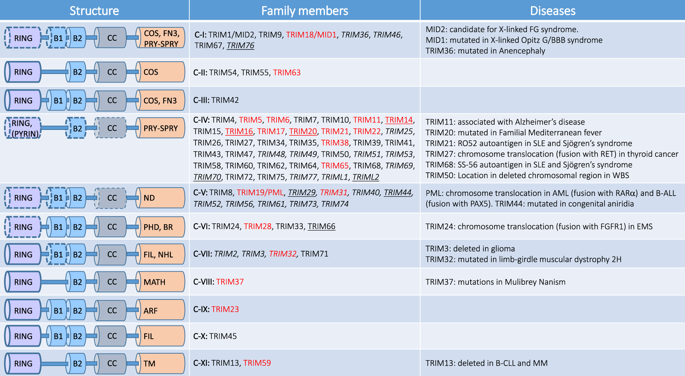当前位置:
X-MOL 学术
›
Cell Death Differ.
›
论文详情
Our official English website, www.x-mol.net, welcomes your feedback! (Note: you will need to create a separate account there.)
TRIM proteins in autophagy: selective sensors in cell damage and innate immune responses.
Cell Death and Differentiation ( IF 12.4 ) Pub Date : 2020-01-22 , DOI: 10.1038/s41418-020-0495-2 Martina Di Rienzo 1 , Alessandra Romagnoli 1 , Manuela Antonioli 1 , Mauro Piacentini 1, 2 , Gian Maria Fimia 1, 3
Cell Death and Differentiation ( IF 12.4 ) Pub Date : 2020-01-22 , DOI: 10.1038/s41418-020-0495-2 Martina Di Rienzo 1 , Alessandra Romagnoli 1 , Manuela Antonioli 1 , Mauro Piacentini 1, 2 , Gian Maria Fimia 1, 3
Affiliation

|
Autophagy, a main intracellular catabolic process, is induced in response to a variety of cellular stresses to promptly degrade harmful agents and to coordinate the activity of prosurvival and prodeath processes in order to determine the fate of the injured cells. While the main components of the autophagy machinery are well characterized, the molecular mechanisms that confer selectivity to this process both in terms of stress detection and cargo engulfment have only been partly elucidated. Here, we discuss the emerging role played by the E3 ubiquitin ligases of the TRIM family in regulating autophagy in physiological and pathological conditions, such as inflammation, infection, tumorigenesis, and muscle atrophy. TRIM proteins employ different strategies to regulate the activity of the core autophagy machinery, acting either as scaffold proteins or via ubiquitin-mediated mechanisms. Moreover, they confer high selectivity to the autophagy-mediated degradation as described for the innate immune response, where TRIM proteins mediate both the engulfment of pathogens within autophagosomes and modulate the immune response by controlling the stability of signaling regulators. Importantly, the elucidation of the molecular mechanisms underlying the regulation of autophagy by TRIMs is providing important insights into how selective types of autophagy are altered under pathological conditions, as recently shown in cancer and muscular dystrophy.
中文翻译:

自噬中的 TRIM 蛋白:细胞损伤和先天免疫反应中的选择性传感器。
自噬是一种主要的细胞内分解代谢过程,是响应各种细胞应激而诱导的,以迅速降解有害物质并协调促生存和促死亡过程的活动,以确定受损细胞的命运。虽然自噬机制的主要组成部分已得到很好的表征,但在应激检测和货物吞噬方面赋予该过程选择性的分子机制仅得到部分阐明。在这里,我们讨论 TRIM 家族的 E3 泛素连接酶在炎症、感染、肿瘤发生和肌肉萎缩等生理和病理条件下调节自噬中所发挥的新作用。TRIM 蛋白采用不同的策略来调节核心自噬机制的活性,作为支架蛋白或通过泛素介导的机制发挥作用。此外,它们对先天免疫反应中描述的自噬介导的降解具有高度选择性,其中 TRIM 蛋白介导自噬体内病原体的吞噬,并通过控制信号调节因子的稳定性来调节免疫反应。重要的是,TRIM 调节自噬的分子机制的阐明为了解病理条件下选择性类型的自噬如何改变提供了重要的见解,正如最近在癌症和肌营养不良症中所显示的那样。
更新日期:2020-01-22
中文翻译:

自噬中的 TRIM 蛋白:细胞损伤和先天免疫反应中的选择性传感器。
自噬是一种主要的细胞内分解代谢过程,是响应各种细胞应激而诱导的,以迅速降解有害物质并协调促生存和促死亡过程的活动,以确定受损细胞的命运。虽然自噬机制的主要组成部分已得到很好的表征,但在应激检测和货物吞噬方面赋予该过程选择性的分子机制仅得到部分阐明。在这里,我们讨论 TRIM 家族的 E3 泛素连接酶在炎症、感染、肿瘤发生和肌肉萎缩等生理和病理条件下调节自噬中所发挥的新作用。TRIM 蛋白采用不同的策略来调节核心自噬机制的活性,作为支架蛋白或通过泛素介导的机制发挥作用。此外,它们对先天免疫反应中描述的自噬介导的降解具有高度选择性,其中 TRIM 蛋白介导自噬体内病原体的吞噬,并通过控制信号调节因子的稳定性来调节免疫反应。重要的是,TRIM 调节自噬的分子机制的阐明为了解病理条件下选择性类型的自噬如何改变提供了重要的见解,正如最近在癌症和肌营养不良症中所显示的那样。


























 京公网安备 11010802027423号
京公网安备 11010802027423号